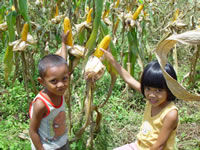Why make GM crops?
Traditionally, a plant breeder tries to exchange genes between two plants to produce offspring that have desired traits. This is done by transferring the male (pollen) of one plant to the female organ of another.
This cross breeding, however, is limited to exchanges between the same or very closely related, characteristics of species. It can also take a long time to achieve desired results and frequently interest do not exist in any related species.
GM technology enables plant breeders to bring together in one plant useful genes from a wide This range of living sources, not just from within the crop species or from closely related plants. powerful tool allows plant breeders to do faster what they have been doing for years – generate superior plant varieties – although it expands the possibilities beyond the limits imposed by conventional plant breeding.
Who produces GM crops?
Most of the research on GM crops has been carried out in developed countries, mainly in North America, Latin America, and Europe. Recently, however, many developing countries have also established the capacity for genetic engineering.
In developed countries, the new life sciences companies have dominated the application of GM technology to agriculture. These include Bayer CropScience, Dow AgroSciences, DuPont/Pioneer, Monsanto, and Syngenta.
What is a GM crop?
A GM or transgenic crop is a plant that has a novel combination of genetic material obtained through the use of modern biotechnology.
For example, a GM crop can contain a gene(s) that has been artificially inserted instead of the plant acquiring it through pollination.
The resulting plant is said to be "genetically modified" although in reality all crops have been "genetically modified" from their original wild state by domestication, selection, and controlled breeding over long periods of time.
Where are GM crops currently grown?
In 1994, Calgene's delayed-ripening tomato (Flavr-Savr™) became the first genetically modified food crop to be produced and consumed in an industrialized country. Since the recorded commercialization of GM crops in 1996 to 2011, several countries have contributed to 94-fold increase in the global area of transgenic crops.
The area planted to GM crops shot up from 1.7 million hectares in 1996 to 160 million hectares in 2011, with an increasing proportion grown by developing countries. In 2011, there were 29 biotech countries, 17 of which growing 50,000 hectares or more, 19 developing countries and 10 industrial countries; they were, in order of hectarage: USA, Brazil, Argentina, India, Canada, China, Paraguay, Pakistan, South Africa, Uruguay, Bolivia, Australia, Philippines, Myanmar, Burkina Faso, Mexico, Spain, Colombia, Chile, Honduras, Portugal, Czech Republic, Poland, Egypt, Slovakia, Romania, Sweden, Costa Rica, and Germany (James, 2011)
What are the potential benefits of GM plants?
In the developed world, there is clear evidence that the use of GM crops has resulted in significant benefits. These include:
- Higher crop yields
- Reduced farm costs
- Increased farm profit
- Improvement in health and the environment
These “first generation” crops have proven their ability to lower farm-level production costs. Now, research is focused on “second-generation” GM crops that will feature increased nutritional and/or industrial traits. These crops will have more direct benefits to consumers. Examples include:
- Rice enriched with iron, vitamin A and E, and lysine
- Potatoes with higher starch content, and inulin
- Edible vaccines in maize, banana and potatoes
- Maize varieties with low phytic acid and increased essential amino acids
- Healthier oils from soybean and canola
- Allergen-free nuts
How are GM crops made?
GM crops are made through a process known as genetic engineering. Genes of commercial interest are transferred from one organism to another. Two primary methods currently exist for introducing transgenes into plant genomes. The first involves a device called a ‘gene gun.’ The DNA to be introduced into the plant cells is coated onto tiny particles of gold or tungsten. These particles are then physically shot onto plant cells. Some of the DNA comes off and is incorporated into the DNA of the recipient plant. The second method uses a bacterium to introduce the gene(s) of interest into the plant DNA.
Are GM crops appropriate for developing countries?
While most of the debate over transgenic crops has taken place mainly in the developed nations in the North, the South stands to benefit from any technology that can increase food production, lower food prices, and improve food quality.
In countries where there is often not enough food to go around and where food prices directly affect the incomes of majority of the population, the potential benefits of GM crops cannot be ignored. It is true that nutritionally enhanced foods may not be a necessity in developed countries but they could play a key role in helping to alleviate malnutrition in developing countries.
Although the potential benefits of GM crops are large in developing countries, they would require some investments. Most developing countries lack the scientific capacity to assess the biosafety of GM crops, the economic expertise to evaluate their worth, the regulatory capacity to implement guidelines for safe deployment, and the legal systems to enforce and punish transgressions in law. Fortunately, several organizations are working to build local capacity to manage the acquisition, deployment, and monitoring of GM crops.
What are the potential risks of GM plants?
With every new emerging technology, there are potential risks. These include:
- The danger of unintentionally introducing allergens and other anti-nutrition factors in foods
- The likelihood of transgenes escaping from cultivated crops into wild relatives
- The potential for pests to evolve resistance to the toxins produced by GM crops
- The risk of these toxins affecting non-target organisms.
Where legislation and regulatory institutions are in place, there are elaborate steps to precisely avoid or mitigate these risks. It is the obligation of the technology innovators (i.e., scientists), producers, and the government to assure the public of the safety of the novel foods that they offer as well as their benign effect on the environment.
There are also those risks that are neither caused nor preventable by the technology itself. An example of this type of risk is the further widening of the economic gap between developed countries (technology users) versus developing countries (nonusers). These risks, however, can be managed by developing technologies tailor made for the needs of the poor and by instituting measures so that the poor will have access to the new technologies.
Conclusion
Despite the current uncertainty over GM crops, one thing remains clear. This technology, with its potential to create economically important crop varieties, is simply too valuable to ignore. There are, however, some valid concerns. If these issues are to be resolved, decisions must be based on credible, science-based information.
Finally, given the importance people place on the food they eat, policies regarding GM crops will have to be based on an open and honest debate involving a wide cross-section of society.





